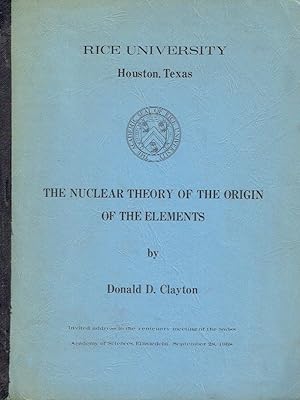donald clayton editor rice university (1 risultati)
Tipo di articolo
- Tutti gli articoli
- Libri (1)
- Riviste e Giornali
- Fumetti
- Spartiti
- Arte, Stampe e Poster
- Fotografie
- Mappe
-
Manoscritti e
Collezionismo cartaceo
Condizioni
- Tutte
- Nuovi
- Antichi o usati
Legatura
- Tutte
- Rilegato
- Brossura
Ulteriori caratteristiche
- Prima edizione
- Copia autografata
- Sovraccoperta
- Con foto
- No print on demand
Paese del venditore
Valutazione venditore
-
The Nuclear Theory of the origin of the Elements
Editore: Academy of Science Einsiedeln, 1968
Da: Versandantiquariat Funke, Dresden, Germania
Libro
Condizione: guter Zustand. guter Zustand, Gebrauchs- und Alterungsspuren: Umschlag teils vergilbt - Umschlag und Seiten teils etwas eselsohrig, Umschlag an den Ecken auch geknickt - Seiten teils mit kleinen Randblessuren - eine Seite an der oberen Ecke defekt - Seiten überwiegend sauber und ordentlich, mit zahlreichen farbigen Textmarkierungen "Donald Delbert Clayton (born March 18, 1935) is an American astrophysicist whose most visible achievement was the prediction from nucleosynthesis theory that supernovae are intensely radioactive. That earned Clayton the NASA Exceptional Scientific Achievement Medal (1992) for ?theoretical astrophysics related to the formation of (chemical) elements in the explosions of stars and to the observable products of these explosions? Supernovae thereafter became the most important stellar events in astronomy owing to their profoundly radioactive nature. Not only did Clayton discover radioactive nucleosynthesis during explosive silicon burning in stars but he also predicted a new type of astronomy based on it, namely the associated gamma-ray line radiation emitted by matter ejected from supernovae. That paper was selected as one of the fifty most influential papers in astronomy during the twentieth century for the Centennial Volume of the American Astronomical Society. He gathered support from influential astronomers and physicists for a new NASA budget item for a gamma-ray-observatory satellite, achieving successful funding for Compton Gamma Ray Observatory. With his focus on radioactive supernova gas Clayton discovered a new chemical pathway causing carbon dust to condense there by a process that is activated by the radioactivity.Clayton's foundational ideas for five original subfields of astrophysics are detailed in Section 5 below. They are: nucleosynthesis, the assembly within stars of the atomic nuclei of the common chemical elements by nuclear reactions occurring therein; astronomical detection of gamma-ray lines emitted by radioactive atoms created and ejected by supernovae; mathematical models of the growth over time of the interstellar abundances of radioactive atoms; predictions of the existence of interstellar cosmic dust grains from individual stars?individual chunks of long-dead stars. He named those stardust, each containing isotopically identifiable radioactive atoms of the host stars; predictions of the condensation of solid grains of pure carbon within hot, oxygen-dominated radioactive supernova gases. Clayton launched these original ideas from research positions at California Institute of Technology, Rice University, Cambridge University (England), Max-Plank Institute for Nuclear Physics (Germany), Durham University (England) and Clemson University during an international academic career spanning six decades.Clayton also authored four books for the public: a novel, The Joshua Factor (1985), is a parable of the origin of mankind utilizing the mystery of solar neutrinos; a science autobiography, Catch a Falling Star; a mid-career memoir The Dark Night Sky, of cultural interest owing to Clayton's conception of it in 1970 as layout for a movie: 245?249 with Italian filmmaker Roberto Rossellini about growing awareness during a cosmological life (See Personal below); Handbook of Isotopes in the Cosmos (Cambridge Univ. Press, 2003), describing in prose the nuclear origin of each isotope of our natural elements and important evidence supporting each nuclear origin. Clayton has also published on the web Photo Archive for the History of Nuclear Astrophysics from his personal photographs and his researched captions recording photographic history during his research in nuclear astrophysics, a contribution to the history of science." (Wikipedia) Seitenanzahl: 29 Seiten mit 6 Diagrammen Format: ca. 21,5 x 27,5 Halbleinen Englisch.


